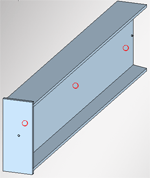
3-D Standard > Tools > New point 
Use the functions of the New point menu to insert and delete points and assign point numbers.
So-called Isolated points are points that do not need to lie on a drawing element but can be freely inserted in the drawing. They serve the purpose of construction aids and can be used, for example, as reference points - also called fitting points - during part transformations. For example, you can use two isolated points to define a rotation axis. Point numbers are used to assign names to points. Named points can be identified directly via their number.

|
New point Inserts new isolated points. Use either the cursor or a point option to specify the point. |
Clicking  opens a pull-down menu with further point functions. opens a pull-down menu with further point functions. |
|

|
New point number Assigns a point number to a point. This is possible for start and end points of edges, isolated and already named points. Identify the point and enter the point number. A special entry is the point number "!" . Here, the following scenarios are possible for part or assembly insertion:
|

|
Delete point Deletes individual isolated points. |

|
Delete point, Active part Deletes all isolated points of the active part. |

|
Delete point number Deletes individual point numbers. Identify the point to which the number has been assigned. |

|
Delete point number, Active part Deletes all point numbers of the active part. |

|
Delete point number, Active drawing Deletes all point numbers of the drawing. |

|
Merge points Combines of the active part lying on the same coordinate into one point. This function enables you, for example, to transform individual, but connected surfaces in one step. |
Isolated points are represented by means of a small circle. Assembly points are displayed slightly larger to enable a direct identification.

You can change the size of isolated points in the Configuration Editor (ISDConfigEditor.exe), at System settings > 2-D lines > Enlargement factor.... The factor can be set for "normal" isolated points (Default: 1) and for assembly points (Default: 1.5). The actual size depends on the value specified in the GRAPAR.DAT system file (HiCAD sys directory) at Radius Signatur (Line14), and the enlargement factor.
 Isolated points and point numbers are only visible if the corresponding settings have been made using the Hide/Show, Via element type function. You access this function via Drawing > Others > Visualisation or via a right-click on the drawing name in the ICN.
Isolated points and point numbers are only visible if the corresponding settings have been made using the Hide/Show, Via element type function. You access this function via Drawing > Others > Visualisation or via a right-click on the drawing name in the ICN.
Related Topics
Point Functions (3-D) • Edge Functions (3-D) • Surface Functions (3-D) • Visualisation Settings
|
Version 2102 - HiCAD 3-D | Date: 15/11/2016 | © Copyright 1994-2016, ISD Software und Systeme GmbH |